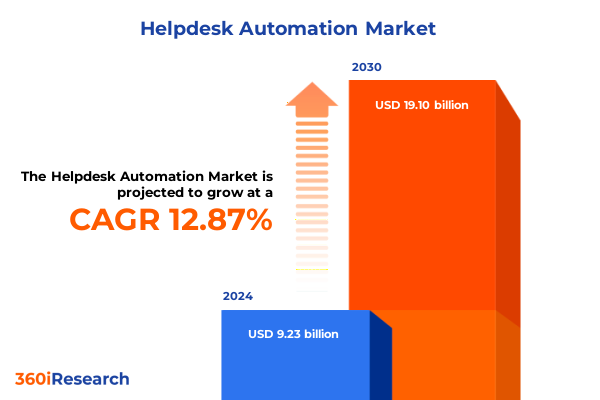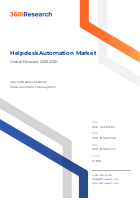The Helpdesk Automation Market size was estimated at USD 9.23 billion in 2024 and expected to reach USD 10.43 billion in 2025, at a CAGR 12.87% to reach USD 19.10 billion by 2030.

Introduction to Helpdesk Automation
Helpdesk automation has emerged as a pivotal force reshaping how organizations manage customer support, streamline internal IT requests, and optimize resource allocation. By replacing manual ticket routing with intelligent workflows, businesses accelerate response times and improve service consistency. This shift is underpinned by advances in artificial intelligence, machine learning, and process orchestration, enabling dynamic prioritization and self-service capabilities. Enterprises across sectors-from education and healthcare to finance and manufacturing-are leveraging automated solutions to reduce operational costs, elevate end-user satisfaction, and free up skilled personnel for strategic initiatives. As customer expectations continue to rise, helpdesk automation offers a scalable foundation for delivering personalized experiences at every touch point. This executive summary explores transformative trends, assesses the impact of evolving trade policies, highlights segment-specific patterns, and provides actionable guidance for leaders seeking to harness the next wave of support innovation.
Transformative Shifts Shaping the Helpdesk Automation Landscape
Over the past decade, several transformative shifts have converged to redefine the helpdesk landscape. First, the proliferation of AI-driven conversational agents has moved routine inquiries away from human agents, allowing support teams to focus on high-value tasks. Second, widespread adoption of hybrid and remote work models has increased the volume and complexity of support requests, driving demand for centralized, cloud-ready platforms. Third, escalating customer expectations for near-instant resolutions have fueled investment in real-time analytics and predictive routing engines that anticipate user needs before service degradations occur. Additionally, seamless integration with enterprise collaboration suites and IT asset management tools has become indispensable, ensuring that support workflows align with broader digital transformation initiatives. Finally, a heightened emphasis on data privacy and regulatory compliance has prompted vendors to embed robust governance controls within their automation frameworks. Together, these shifts are elevating helpdesk automation from a cost-saving measure to a strategic enabler of operational resilience and customer loyalty.
Cumulative Impact of United States Tariffs 2025
The introduction of new U.S. tariffs in 2025 has created a ripple effect across the helpdesk automation ecosystem, particularly affecting hardware procurement and global supply chains. Organizations dependent on imported servers, networking gear, and on-premises appliances have grappled with increased capital expenditures, prompting a reevaluation of infrastructure strategies. In response, some enterprises have accelerated their migration to cloud-based solutions, mitigating tariff exposure by prioritizing software-as-a-service models and leveraging regionally distributed data centers. Meanwhile, vendors have renegotiated supply agreements and expanded local manufacturing partnerships to preserve margin stability. These developments have reinforced the importance of flexible licensing terms and scalable subscription plans, enabling buyers to adjust capacity without incurring hefty tariff-related surcharges. As geopolitical dynamics continue to evolve, businesses are embedding tariff risk assessments into their procurement roadmaps, ensuring that helpdesk automation investments remain both cost-effective and compliant.
Key Segmentation Insights Across Industries, Solutions, Services, and Enterprise Scale
A closer look at industry deployment reveals that sectors such as healthcare and finance are among the most active adopters, with hospital networks and banking institutions leveraging automation to meet stringent service-level agreements and regulatory mandates. Higher education and e-commerce retailers have similarly prioritized automated ticketing and knowledge management to handle peak volume demands. On the solution front, a clear divide has emerged between on-premises hardware offerings-favored by government agencies and large enterprises requiring maximum control-and cloud-based platforms, which attract mid-sized organizations seeking rapid deployment and lower upfront costs. Service models further underscore this dichotomy: infrastructure management and IT support under managed services enable organizations to shift maintenance responsibilities to third parties, while consulting and implementation engagements empower professional service firms to tailor workflows and data integrations. Finally, organization size plays a defining role in feature requirements and budget cycles. Large enterprises demand enterprise-grade security, multi-tenant orchestration, and advanced analytics, whereas small and medium enterprises favor user-friendly interfaces, subscription pricing, and modular add-ons that scale with business growth. Collectively, these segmentation insights help vendors and buyers align solution portfolios with specific operational priorities and risk profiles.
This comprehensive research report categorizes the Helpdesk Automation market into clearly defined segments, providing a detailed analysis of emerging trends and precise revenue forecasts to support strategic decision-making.
- Industry Deployment
- Solution Type
- Service Model
- Organization Size
Key Regional Insights Driving Helpdesk Automation Adoption
Regional dynamics reveal distinct drivers and adoption patterns. In the Americas, emphasis on customer experience and digital innovation fuels investment in conversational AI, omni-channel support, and analytics. Latin American markets, in particular, are exploring automation to overcome resource constraints and infrastructure variability. Across Europe, the Middle East, and Africa, stringent data protection regulations and regional interoperability standards guide platform selection, leading to robust deployment of on-premises and hybrid automation architectures. EMEA organizations also prioritize multilingual support and cross-border compliance. Meanwhile, in the Asia-Pacific region, rapid digitization initiatives in emerging economies, coupled with government-backed smart city programs, accelerate uptake of cloud-based helpdesk services. APAC enterprises are increasingly turning to managed service partners to navigate complex regulatory landscapes and localize AI-driven self-service portals. These regional insights inform tailored go-to-market strategies and help buyers contextualize vendor roadmaps within their jurisdictional frameworks.
This comprehensive research report examines key regions that drive the evolution of the Helpdesk Automation market, offering deep insights into regional trends, growth factors, and industry developments that are influencing market performance.
- Americas
- Asia-Pacific
- Europe, Middle East & Africa
Key Companies Insights in the Evolving Helpdesk Automation Ecosystem
The competitive landscape features a diverse roster of established giants and agile challengers. Atlassian and Freshworks have positioned themselves as collaborative platform champions, integrating ticketing with development workflows and enabling seamless cross-functional communication. Broadcom and BMC Software maintain strong footholds among large enterprises, offering comprehensive suites that bundle asset management, incident response, and compliance reporting. Cloud-native pioneers like Zendesk and Zoho have prioritized ease of use and rapid onboarding, appealing to small and medium enterprises seeking quick wins. Meanwhile, vendors such as ServiceNow and SolarWinds focus on deep IT service management integration, catering to organizations that require end-to-end visibility across networks and applications. Emerging specialized players-BrightDesk by Syncfusion, BoldDesk, and HappyFox-differentiate through vertical-specific templates, AI-augmented knowledge bases, and customizable automation recipes. Finally, mid-tier service providers including Kaseya, Ivanti, and SysAid are closing feature gaps by expanding into cloud migration support and advanced analytics. Together, this constellation of providers underscores a market in flux, where strategic partnerships, continuous innovation, and user-centric design determine competitive advantage.
This comprehensive research report delivers an in-depth overview of the principal market players in the Helpdesk Automation market, evaluating their market share, strategic initiatives, and competitive positioning to illuminate the factors shaping the competitive landscape.
- Atlassian Pty Ltd
- BMC Software, Inc.
- BoldDesk by Syncfusion, Inc.
- Broadcom, Inc.
- Freshworks Technologies Pvt. Ltd.
- FrontApp, Inc.
- HappyFox Inc.
- Help Scout PBC
- Infraon Corp.
- ITaraian, LLC
- Ivanti, Inc.
- Kaseya Limited
- Kayako Limited
- ProProfs
- Resolve Systems, LLC
- Serviceaide, Inc.
- ServiceNow, Inc.
- SolarWinds Worldwide, LLC
- Sunrise Software Limited
- SysAid Technologies
- Vortex Software Inc.
- Zendesk, Inc.
- Zoho Corporation Pvt. Ltd.
Actionable Recommendations for Industry Leaders
To capitalize on the momentum in helpdesk automation, industry leaders should adopt a multi-pronged approach. First, invest in AI and machine learning capabilities that enhance predictive triage and personalized self-service, reducing resolution times and improving user satisfaction. Second, prioritize open APIs and integration frameworks to facilitate seamless data exchange with CRM systems, IT asset management tools, and collaboration platforms. Third, develop flexible consumption models-such as pay-as-you-grow subscriptions-to lower entry barriers for emerging business units while scaling with increased demand. Fourth, strengthen security and compliance controls by embedding encryption, audit logging, and role-based access into each workflow. Fifth, foster strategic partnerships with regional managed service providers to navigate local regulations and accelerate deployment. Sixth, implement continuous feedback loops via in-platform surveys and usage analytics to refine automation scripts and knowledge articles. Finally, build internal change management programs that upskill support staff, ensuring they can manage escalations and maintain high customer engagement as automation handles repetitive tasks. This comprehensive approach positions organizations to drive sustained efficiency gains and strategic value from their helpdesk investments.
Explore AI-driven insights for the Helpdesk Automation market with ResearchAI on our online platform, providing deeper, data-backed market analysis.
Ask ResearchAI anything
World's First Innovative Al for Market Research
Conclusion and Strategic Outlook
Helpdesk automation stands at the intersection of technology innovation and customer-centric service delivery. By synthesizing the latest trends-advanced AI, cloud-first deployment, and adaptive tariff strategies-with granular segment and regional insights, decision-makers can craft targeted roadmaps that deliver both immediate efficiencies and long-term competitive differentiation. A pragmatic focus on integration, flexible commercial models, and continuous optimization will enable organizations to stay ahead of evolving user expectations and regulatory landscapes. As the market continues to mature, successful adopters will be those who balance rapid innovation with measured governance, ensuring that automated processes remain aligned with overarching business objectives. This executive summary offers a blueprint for harnessing helpdesk automation as a strategic asset, empowering enterprises to transform support operations into a catalyst for growth and resilience.
This section provides a structured overview of the report, outlining key chapters and topics covered for easy reference in our Helpdesk Automation market comprehensive research report.
- Preface
- Research Methodology
- Executive Summary
- Market Overview
- Market Dynamics
- Market Insights
- Cumulative Impact of United States Tariffs 2025
- Helpdesk Automation Market, by Industry Deployment
- Helpdesk Automation Market, by Solution Type
- Helpdesk Automation Market, by Service Model
- Helpdesk Automation Market, by Organization Size
- Americas Helpdesk Automation Market
- Asia-Pacific Helpdesk Automation Market
- Europe, Middle East & Africa Helpdesk Automation Market
- Competitive Landscape
- ResearchAI
- ResearchStatistics
- ResearchContacts
- ResearchArticles
- Appendix
- List of Figures [Total: 24]
- List of Tables [Total: 722 ]
Call to Action: Connect with Ketan Rohom for Detailed Report Access
To secure the full market research report and gain deeper insights into helpdesk automation trends, reach out to Ketan Rohom, Associate Director, Sales & Marketing. Take the next step toward unlocking operational excellence and customer satisfaction.

- How big is the Helpdesk Automation Market?
- What is the Helpdesk Automation Market growth?
- When do I get the report?
- In what format does this report get delivered to me?
- How long has 360iResearch been around?
- What if I have a question about your reports?
- Can I share this report with my team?
- Can I use your research in my presentation?




